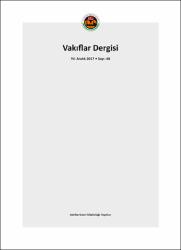Osmanlı’da icâreteyn uygulaması hakkında yeni değerlendirmeler
Künye
PATIK, Ramazan. "Osmanlı’da icâreteyn uygulaması hakkında yeni değerlendirmeler." Vakıflar Dergisi, 48 (2017): 75-104.Özet
Osmanlı vakıf kurumlarıyla ilgili yaygın olarak paylaşılan eleştirilerden biri vakıf kurumlarının hukuksal
ve idarî yapısındaki katılık nedeniyle kentsel gelirlerini oluşturan kira gelirlerinin artan fiyat hareketlerine
adapte edemediği ve neticede vakıfların gelir kaybına uğradığı hususudur. Bu çalışmada vakıfların,
artan fiyat hareketleri, doğal ve beşeri etkenler neticesinde tahribata ve kesintiye uğrayan kent içi gayrimenkullerinin
değerlendirilmesinde icareteyn sisteminden etkin bir şekilde faydalanması tartışılacaktır.
Osmanlı gayrimenkul piyasasında etkin değerleme yöntemi olarak icâreteyn sistemi 19. yüzyılın ortalarına
kadar vakıf gayrimenkul piyasasında en önemli kiralama biçimi olarak varlığını korumuştur.
İcâreteyn, mülklerini tamir veya yeniden inşa etmeye mali gücü olmayan vakıflar için, kasasından hiç
para çıkmadan mülkünün yeniden işler hale getirilmesini sağlayarak birçok vakıf taşınmazının uzun
süre ayakta kalmasını sağlamıştır.
Bu çalışmada icâreteynin uygulanış pratiğine ilişkin şerʻiyye sicilleri, vakfiye, vakıf temessük defterleri,
Evkâf-ı Hümâyûn Müfettişliği mahkeme kayıtları ve vakıf muhasebe defterlerindeki verilerden hareketle
icâreteyn hakkındaki bazı nazariyeler ve İstanbul örneğinde sistemin sözleşmenin taraflarına ne tür
avantajlar sağladığı tahlil edilmiştir. It is widely argued that the Ottoman waqf institutions lacked the flexibility to revise the rent incomes
from the real estates they owned when there was a price increase in the rental market. This inflexibility,
which was originated from the waqf system’s rigid legal and administrative structures, became the
reason for the waqf institutions to lose a significant part of their incomes. This study, however, claims
that the Ottoman waqf institutions greatly benefited from the icareteyn, or double-rent system, which
allowed the administrators of the waqfs to re-evaluate the rents of the urban real estates in the face of
inflation. This study argues that the double-rent system remained as the most effective way of leasing
method in the Ottoman waqf real estate market until the middle of the nineteenth century. It helped
the waqfs, particularly those deprived of financial means to restore and/or reconstruct their real estates,
to finance their maintenance without spending from their budgets.
Based on a variety of primary sources including court records, endowment deeds, waqf temessük registers,
court records of the Imperial Pious Foundations Inspectorship (Evkâf-ı Hümâyûn Müfettişliği),
and waqf account registers, this study aims to highlight some of the theories on the icareteyn system
and how it provided advantages for both parties who signed the contract. Examples will be drawn from
the cases in Istanbul in the early modern period.
Bağlantı
http://dergipark.gov.tr/uploads/issuefiles/4dc1/312a/b29c/5a4e0c0ec44f7.pdfhttps://hdl.handle.net/11352/2663
Koleksiyonlar
- Vakıflar Dergisi [825]



















